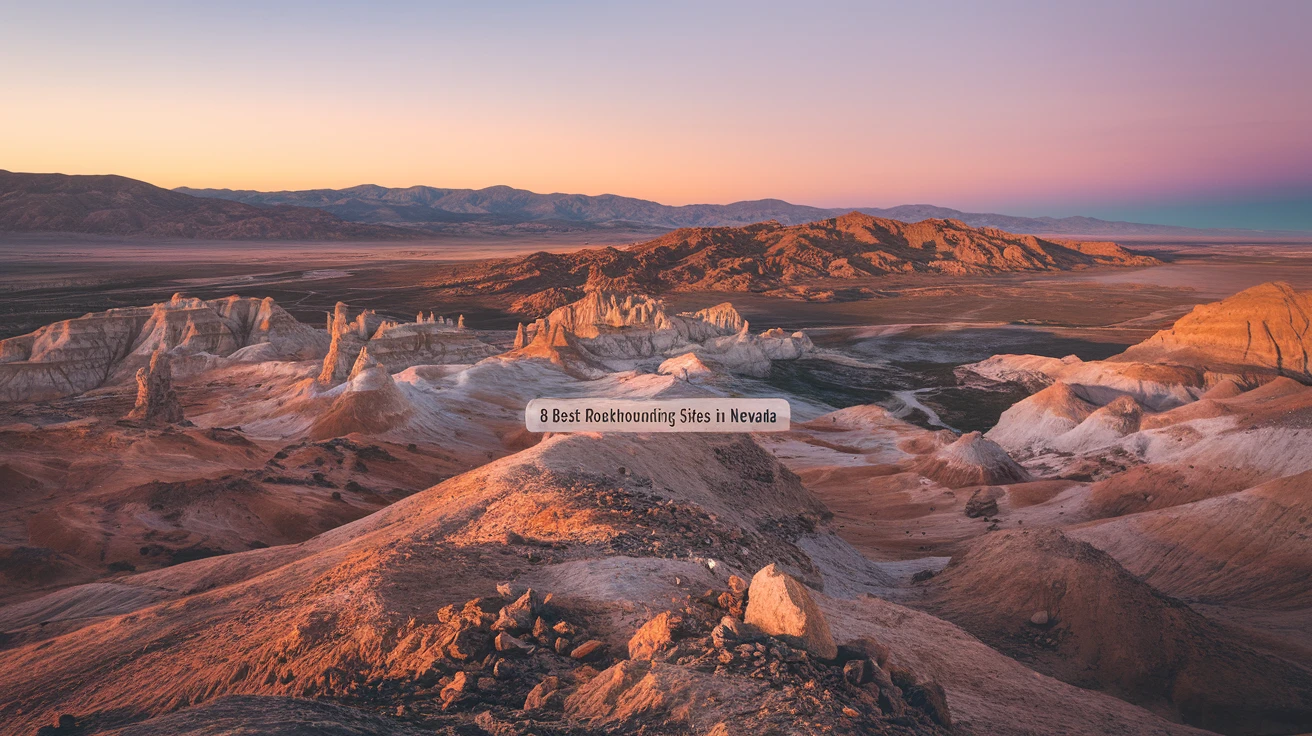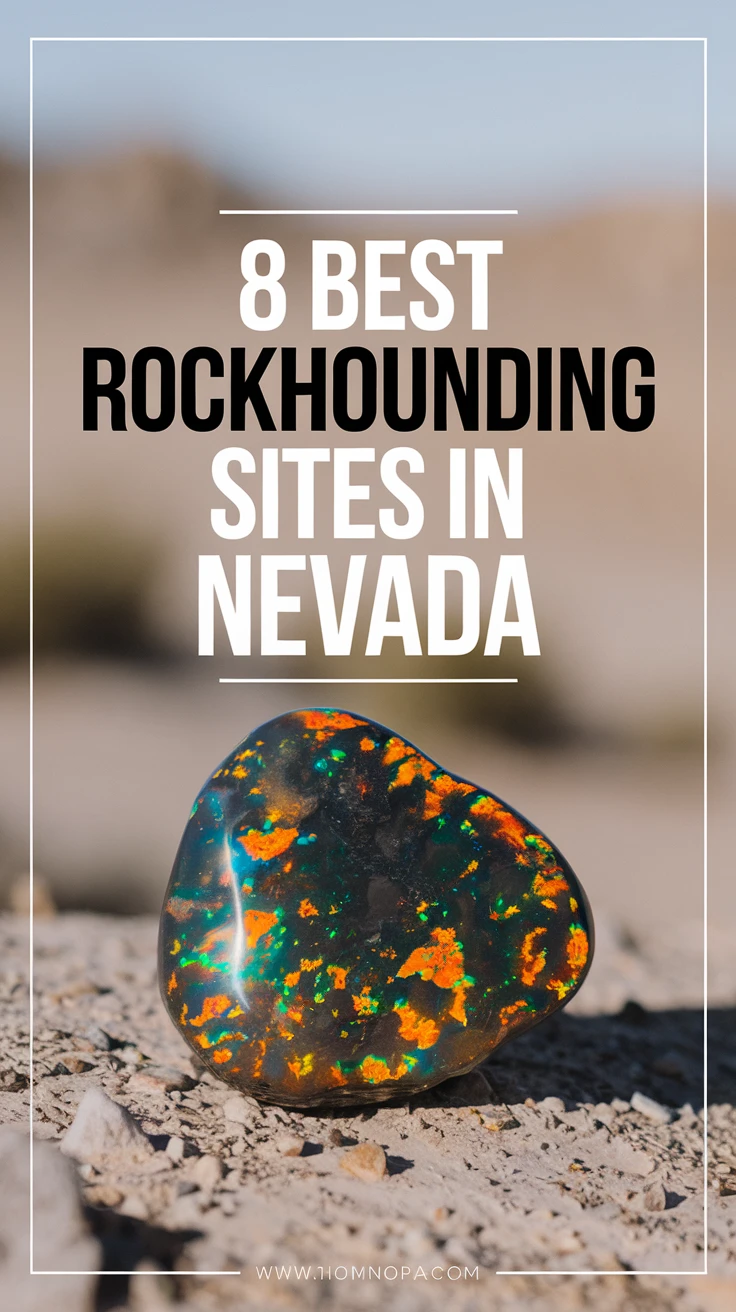
Nevada’s vast desert landscape holds more than just gambling destinations and ghost towns – it’s a treasure trove for rock and mineral enthusiasts. As someone who’s spent countless weekends exploring these mineral-rich territories, I can tell you that rockhounding in Nevada is an adventure unlike any other. From precious opals that rival Australia’s finest to garnets that gleam in the desert sun, the Silver State offers some of the most diverse mineral collecting opportunities in the United States. In this comprehensive guide, we’ll explore eight of Nevada’s most rewarding rockhounding locations, drawing from personal experience and expert knowledge to help you make the most of your mineral hunting adventures.
Essential Equipment and Preparation
Before we dive into the specific locations, let’s cover the crucial equipment you’ll need for a successful rockhounding expedition in Nevada:
| Basic Equipment | Safety Gear | Optional Tools |
|---|---|---|
| – Rock hammer – Safety goggles – Collection bags – GPS device | – First aid kit – Sun protection – Water containers – Emergency beacon | – UV light – Screening tools – Digital microscope – Mining picks |
Remember to check local regulations and obtain any necessary permits before heading out. Many locations require advance permission or have specific rules about collection limits.
1. Virgin Valley: Opal Hunter’s Paradise
Located in northern Nevada, Virgin Valley is world-renowned for its precious black opals. During my first visit here, I was amazed by the quality of specimens that rival Australian opals. The area hosts several pay-to-dig mines, including the famous Rainbow Ridge and Royal Peacock mines.
Best Time to Visit: Late spring to early fall
Specimens Found: Black opal, precious opal, common opal
Difficulty Level: Moderate to challenging
Tips for Success:
– Make reservations in advance during peak season
– Bring plenty of water and sun protection
– Start early in the morning to avoid extreme heat
– Pack tools for digging through clay-like material
2. Garnet Hill: A Gem Lover’s Dream
Just outside of Ely, Garnet Hill is one of my favorite locations for beginners. The site is freely accessible and offers abundant almandine garnets embedded in host rock. I’ll never forget finding my first thumbnail-sized garnet here – it still sits on my desk as a paperweight.
| Season | Conditions | Recommended Equipment |
|---|---|---|
| Spring/Fall | Ideal temperature, clear skies | Basic rock hammer, chisel |
| Summer | Very hot, early morning best | Extra water, sun protection |
| Winter | Limited access, cold | Warm gear, 4×4 vehicle |
3. Gold Butte National Monument
This remote area offers diverse collecting opportunities, from agate to chalcedony. The landscape itself is breathtaking, with red sandstone formations providing a dramatic backdrop to your rockhounding adventure.
Key Features:
– Multiple collection areas within the monument
– Various mineral types available
– Spectacular desert landscape
– Remote location requires preparation
Remember to bring:
– High-clearance vehicle
– Extra fuel
– Navigation equipment
– Emergency supplies
4. Rainbow Ridge Opal Mine
As a commercial operation, Rainbow Ridge offers a unique experience for opal hunters. The mine provides tools and guidance, making it perfect for both novices and experienced rockhounds.
Daily Operations:
– Operating hours: 7 AM to 3 PM (May-September)
– Fees apply for digging
– Tools available for rent
– Expert guidance on site
I once spent three days here and found several quality specimens, including a stunning black opal that now sits in my personal collection.
5. Royal Peacock Mine
Another excellent opal location, Royal Peacock Mine offers both bank digging and mine tailings exploration. The staff here is incredibly knowledgeable and helpful – they taught me techniques I still use today.
Collection Methods:
– Bank digging (more challenging but potentially more rewarding)
– Tailings search (easier, good for beginners)
– Virgin ground exploration (seasonal availability)
– Guided experiences available
6. Peterson Mountain
Known for its smoky quartz crystals, Peterson Mountain straddles the Nevada-California border. This location requires some hiking but rewards persistent rockhounds with spectacular specimens.
What You Might Find:
– Smoky quartz crystals
– Clear quartz
– Amethyst (rare)
– Mineral specimens in vugs
7. Gabbs: Turquoise Territory
The area around Gabbs is famous for its high-quality turquoise. While many claims are private, there are still public areas where rockhounds can search for this precious stone.
Essential Information:
– Verify public access areas before collecting
– Research claim boundaries
– Bring proper digging tools
– Be prepared for remote conditions
8. Topaz Mountain: Crystal Clear Beauty
Despite its name, this location offers more than just topaz. You can find various minerals including beryl and garnet. The site requires some hiking but offers remarkable views of the surrounding landscape.
Collection Tips:
– Look for float material in wash areas
– Check exposed rock faces
– Dig in decomposed granite
– Screen material for small specimens
Conclusion
Nevada’s rockhounding sites offer something for everyone, from complete beginners to seasoned collectors. Always remember to follow local regulations, practice responsible collecting, and come prepared for desert conditions. The thrill of finding your own specimens makes every trip worthwhile, even if you don’t strike it rich with precious opal or turquoise.
Key Takeaways
- Always check permissions and permits before rockhounding
- Bring plenty of water and sun protection
- Pack appropriate tools for the specific location
- Research the best seasons for each site
- Practice responsible collecting techniques
Frequently Asked Questions
Do I need a permit to go rockhounding in Nevada?
Some locations require permits or fees, particularly commercial mines. Always check local regulations and obtain necessary permissions before collecting.
What’s the best season for rockhounding in Nevada?
Spring and fall offer the most comfortable temperatures. Summer can be extremely hot, while winter may limit access to certain locations.
Can beginners find good specimens in Nevada?
Yes! Many locations, especially Garnet Hill and the commercial opal mines, are suitable for beginners and often yield good finds.
What tools do I absolutely need?
Essential tools include a rock hammer, safety goggles, collection bags, and navigation equipment. Specific locations may require additional tools.
Are there any dangerous animals to watch out for?
Yes, rattlesnakes and scorpions are common in Nevada. Always watch where you step and reach, and wear appropriate protective gear.
How much does it cost to dig at commercial mines?
Fees vary by location but typically range from $75 to $200 per day. Some mines offer equipment rental for additional fees.
Can I sell the specimens I find?
Generally yes, if collected from public lands within legal limits or purchased from commercial mines. Some locations may have specific restrictions.
What should I do if I find gold?
Gold claims in Nevada are strictly regulated. Unless you’re on a designated recreational gold panning site, leave any gold discoveries alone.
Are there age restrictions for rockhounding?
Most locations welcome all ages, but commercial mines may have minimum age requirements for safety reasons.
How can I identify my finds?
Join local rockhounding groups, use mineral identification guides, or consult with experts at local rock shops and museums.

